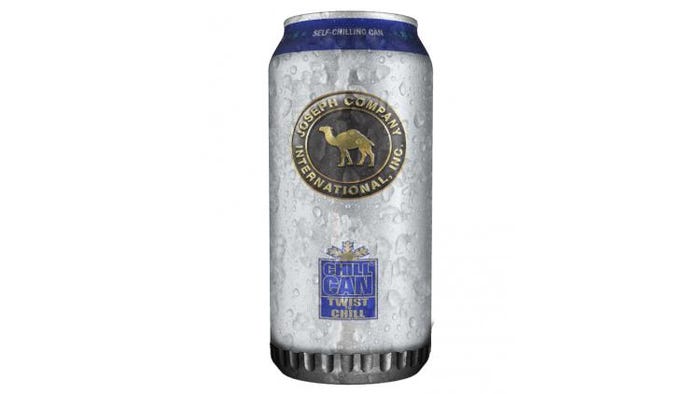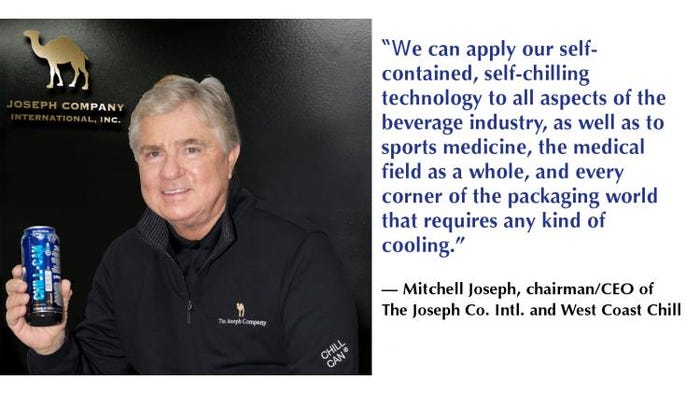Nothing is quite as refreshing as a cold drink. Yet with consumers’ busy lives, always on the go, we don’t always have access to refrigeration when we need it. New technology for a self-chilling can improves its manufacturability, making it a viable option for more brands. And, without the need for ice cubes, self-chilling beverages don’t get watered down, giving consumers a better flavor experience.
The updated technology also simplifies the activation process—from the previous push button to a twist—and changes to a safer activation ingredient. The new two-piece aluminum Chill-Can from The Joseph Co. now uses liquefied CO2 as the active coolant.
Instructions are pretty simple: Turn can upside down, twist the can’s plastic base (which is now at the top) to activate the Heat Exchange Unit (HEU), wait about 75 to 90 seconds for the cooling process to complete, and then turn the can upright, open and enjoy. Watch the video above.
Chilling time depends on the package and the HEU can be sized and shaped appropriately for a package/product. The HEU weighs approximately 150 grams and, once activated, lowers the product’s temperature about 30 degrees.
The Joseph Co. has 31 patents that cover the basis of the technology, the manufacturing process and the HEU coatings. The self-chilling cans are made in The Joseph Co.’s Irvine, CA, manufacturing plant, where they also do research and development—and have access to an ideal test market. A new plant in Youngstown, OH, for light production and distribution, is scheduled to open fall 2018 and is expected to be fully operational in summer 2019. The company also does research and development and small production for Western Europe from its U.K. facility.
Mitchell Joseph, chairman/CEO of The Joseph Co. Intl. and West Coast Chill, explains more about the trends driving the need for a next-generation self-chilling package.
What consumer trends point to the need for self-chilling packaging?
Joseph: Trends that are both socially based and economically based have increased the demand for a self-chilling can. The globalization of smartphones and high-speed internet have created societies that have become accustomed to having what they want, on demand. It has not only changed how people consume, but where they can consume. This type of mindset has translated over into the world of convenience.
The Chill-Can answers the call and is the only commercialized package that chills on demand and stays colder longer than a can taken out of a conventional refrigerator. Conversely, there are many economic regions around the world—in areas as close as 20 miles outside of major metropolitan cities—that lack proper refrigeration. The Chill-Can offers the opportunity to provide an ice cold drink on demand in those areas without major investments in refrigeration infrastructure. Major beverage companies view this as a huge opportunity to reach markets that desire their products but are unable to consume due to lack of refrigeration.
How is this Chill-Can technology different from previous self-chilling packages? Specifically, your company developed the self-chilling can for West Coast Chill energy drink in 2012. What has changed from that development?
Joseph: The first iteration of the Chill-Can, which was licensed to Pepsi, used HFC134A as its main activating agent. Production of that technology was halted over concerns regarding the global warming potential of HFC134A.
The “Activated Carbon” technology that was introduced in 2012 was environmentally friendly but presented a few barriers in mass production. First and foremost, there were pressure profile limitations within the Heat Exchange Unit (HEU) for this version of the technology. Secondly, the activated carbon was ascertained via pulverized and incinerated coconut shells and there was a concern about the long term supply of that source for our activated carbon. Lastly, there was a concern if the pricing, even with large volumes, could be decreased over time using this technology.
Therefore, after 25 years of research and development, we are excited to present our current, patented liquefied CO2-based Chill-Can. Although it has been a long journey, we would have never achieved what we have today without the previous two versions as they unlocked the steps that led us to where we are today.
What is the pressure exerted on the contents of the can during the chilling process? Does this limit the types of products that can be chilled with this technology?
Joseph: Given that the beverage never comes in contact with the inner part of the HEU, there is no pressure exerted on the contents of the can during the chilling process.
Secondly, there are no real limitations to the type of liquid we can chill. Really anything that can be humanly consumed can be packaged in a Chill-Can. In some extreme cases, we may need to make some adjustments based on the viscosity of some drinks, but that is an easy adjustment to make.
Instructions say to twist the bottom cap clockwise to activate. What happens when the cap is twisted to trigger the process?
Joseph: Once the can is fully activated, and any time after that, the cap can still be twisted in a clockwise manner, but the movement is inconsequential and will have no effect on the can following activation completion.
Why change to a twist activation from the earlier push button?
Joseph: Consumer focus test results showed that a twist activation was superior to a push button for two main reasons. First, the twist activation requires a simple clockwise twist to activate, where the button required a slightly more pressure push of the button which left people confused on how much pressure they needed to apply to activate. And second, consumers with long fingernails felt that the push button would be too hard to activate. The twist activation resulted in a better engineered system that required fewer parts during manufacturing.
Will West Coast Chill be switching over to the new twist-activation cans?
Joseph: Yes, all products will use the twist activation going forward.
The bottom cap only twists in the clockwise direction. Is this to make it more intuitive to activate or is there another reason(s)?
Joseph: Yes. This is to make it more intuitive and straightforward for activating.
You say the can will stay colder for longer than a can taken out of a conventional refrigerator by more than 30 minutes. How? Why?
Joseph: When a can is taken out of the refrigerator and/or a cooler, it is immediately warming up based on the outside temperature of the air/atmosphere. The Chill-Can, because it is chilling from the inside-out, continues to chill the beverage by more than 30 minutes. Despite the air temperature, the outside walls of the HEU, which stay in contact with the beverage until it is consumed, are ice cold and will continue to cool the beverage. This feature is viewed as just as revolutionary as the chill on-demand aspect of the Chill-Can. It’s especially appealing to consumers who are continually frustrated that, if they don’t drink an entire can quickly, the last third of the can is undrinkable because the beverage is too warm.
What is the product-to-package ratio of an 8.4 fl-oz can?
Joseph: The HEU obviously causes a displacement factor in the can. We chose 8.4 ounces of fluid originally for West Coast Chill because, for an energy drink, that amount was standard for the market leader at the time. The can samples provided to Packaging Digest were 16-oz cans. We certainly could provide more liquid in the can as needed. However, the HEU will cause about 4 ounces of displacement in a 16-oz can.

What types of containers can the HEU be incorporated into? Aluminum, obviously. Steel? Plastic? Paper? Glass?
Joseph: Currently, aluminum and steel, but ongoing research and development is being done on all types of containers and materials.
The 8.4-fl-oz sample can is about 6.5 inches tall. How does this fit on most store shelves?
Joseph: The sample provided was in a standard 16-oz can and would fit on a shelf or display just as easily as any standard, conventional 16-oz can would.
How does the HEU change product filling? Slower speeds?
Joseph: HEU necessitates only slight modifications to any standard filling line and can be easily done in conjunction with The Joseph Co. This will only result in a minor slowing of production speed.
How well does the Chill-Can run on automatic packaging lines? It seems like the weight of the can is pretty balanced.
Joseph: Currently, the Chill-Can is only assembled on our manufacturing lines. Product filling can be done on outside filling line as just described.
What applications can best benefit from this technology?
Joseph: We feel we can apply our self-contained, self-chilling technology to all aspects of the beverage industry, as well as to sports medicine, the medical field as a whole, and every corner of the packaging world that requires any kind of cooling. The Joseph Co. can provide the solution for any business application that requires cooling without outside energy.

Can this be used for carbonated beverages?
Joseph: Yes. Carbonated beverages and any and all beverages that are suitable for human consumption.
How is the Chill-Can recyclable?
Joseph: All parts of the can are aluminum with about 5% of the parts being plastic. Both materials are 100% recyclable.
At this time, we are crafting a Recapture Program modeled after similar successful programs in Sweden. Someday we hope to be able to recapture large percentages of the cans and reuse some of the parts in production of new Chill-Cans.
The technology is ready for commercialization. Do you have any customers lined up yet?
Joseph: The technology will be licensed to Joseph-owned West Coast Chill and private-label beverages produced under the Joseph banner, such as Panther Punch, which is currently sold in a conventional can in South Florida via licensing with the Florida Panthers of the National Hockey League (NHL).
Mutual non-disclosure agreements prevent us from sharing with you at this time the multiple global beverage companies and retailers whom are under license or under consideration for a license at this time.
How much does the Chill-Can cost? Have you done any calculations on possible savings from eliminating the need for refrigeration during shipping/storage/display?
Joseph: Volume will always dictate price. Consumer focus tests have yielded results that show the consumer is willing to pay a premium for the opportunity to have their favorite beverage in a chill-on-demand package. [Editor’s note: For the West Coast Chill energy drink can, on-demand chilling added $1.50 to the cost of the product and, according to Joseph, “We couldn’t keep them on the shelf.”]
Two life cycle analysis studies do indeed show the huge, positive impact that the elimination of refrigeration will provide.
How are you able to guarantee 100% product / package safety, and what does “100% guaranteed safe” mean?
Joseph: This is why it has taken 25 years to get here. In that time, we have been given awards by the United States EPA [Environmental Protection Agency], gained Department of Transportation approval for shipping the Chill-Can, and have subjected the Chill-Can to years of safety testing to assure the safety of the product. In fact, the can itself is equipped with a safety mechanism that if somehow the can was put in a situation where it could “fail” (which is highly unlikely), it would simply self-activate 100% safely.
Development and refinement of the Chill-Can has taken 25 years. What key lessons have you learned during this process?
Joseph: Excellent question! We have learned patience and resiliency. We have learned that safety must be our highest priority followed by activation reliability, and of course cooling performance. We believe the consumer will think it was worth the wait!
******************************************************************************
Did you know? Our parent company UBM owns these popular packaging events: WestPack, EastPack, PackEx Toronto and PackEx Montreal. Click the links to learn how you can connect in person with leading packaging technology partners, expand your professional network, hear experts analyze key packaging trends and gain a better understanding of today's critical issues.
About the Author(s)
You May Also Like




